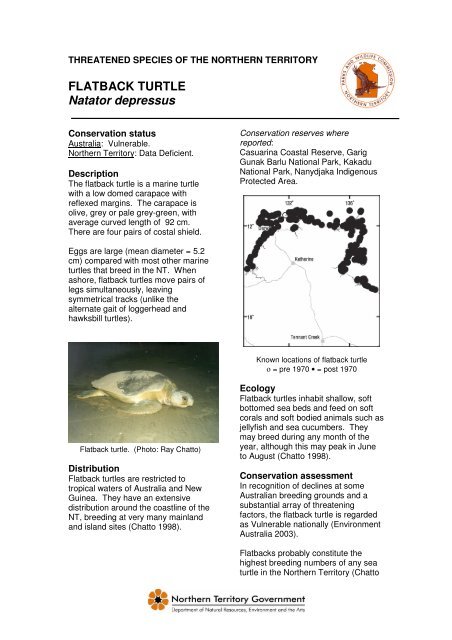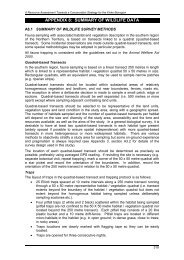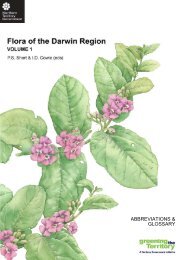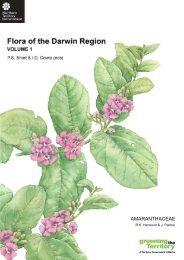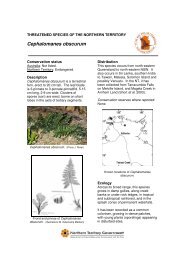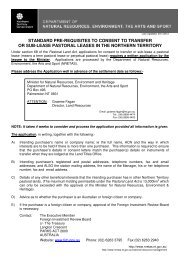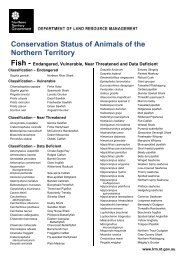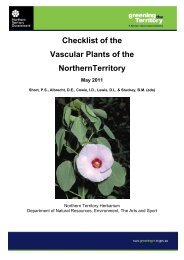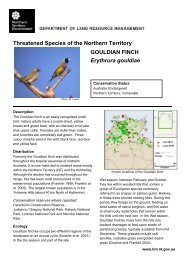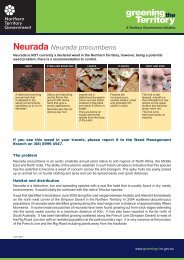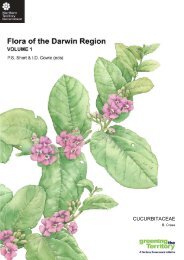FLATBACK TURTLE Natator depressus
FLATBACK TURTLE Natator depressus
FLATBACK TURTLE Natator depressus
Create successful ePaper yourself
Turn your PDF publications into a flip-book with our unique Google optimized e-Paper software.
THREATENED SPECIES OF THE NORTHERN TERRITORY<br />
<strong>FLATBACK</strong> <strong>TURTLE</strong><br />
<strong>Natator</strong> <strong>depressus</strong><br />
Conservation status<br />
Australia: Vulnerable.<br />
Northern Territory: Data Deficient.<br />
Description<br />
The flatback turtle is a marine turtle<br />
with a low domed carapace with<br />
reflexed margins. The carapace is<br />
olive, grey or pale grey-green, with<br />
average curved length of 92 cm.<br />
There are four pairs of costal shield.<br />
Eggs are large (mean diameter = 5.2<br />
cm) compared with most other marine<br />
turtles that breed in the NT. When<br />
ashore, flatback turtles move pairs of<br />
legs simultaneously, leaving<br />
symmetrical tracks (unlike the<br />
alternate gait of loggerhead and<br />
hawksbill turtles).<br />
Flatback turtle. (Photo: Ray Chatto)<br />
Distribution<br />
Flatback turtles are restricted to<br />
tropical waters of Australia and New<br />
Guinea. They have an extensive<br />
distribution around the coastline of the<br />
NT, breeding at very many mainland<br />
and island sites (Chatto 1998).<br />
Conservation reserves where<br />
reported:<br />
Casuarina Coastal Reserve, Garig<br />
Gunak Barlu National Park, Kakadu<br />
National Park, Nanydjaka Indigenous<br />
Protected Area.<br />
Known locations of flatback turtle<br />
ο = pre 1970 • = post 1970<br />
Ecology<br />
Flatback turtles inhabit shallow, soft<br />
bottomed sea beds and feed on soft<br />
corals and soft bodied animals such as<br />
jellyfish and sea cucumbers. They<br />
may breed during any month of the<br />
year, although this may peak in June<br />
to August (Chatto 1998).<br />
Conservation assessment<br />
In recognition of declines at some<br />
Australian breeding grounds and a<br />
substantial array of threatening<br />
factors, the flatback turtle is regarded<br />
as Vulnerable nationally (Environment<br />
Australia 2003).<br />
Flatbacks probably constitute the<br />
highest breeding numbers of any sea<br />
turtle in the Northern Territory (Chatto
1998). In the NT, there are no<br />
substantial data on trends in<br />
population; and the species remains<br />
common and widespread. There is<br />
some anecdotal evidence of at least<br />
localised decline of marine turtles in<br />
general (Kennett et al. 2004).<br />
Given the presence of some threats<br />
that cannot be quantified and the lack<br />
of trend data the species is best<br />
considered as Data Deficient.<br />
Threatening processes<br />
As with other marine turtles, there are<br />
a broad range of factors that may<br />
threaten this species. These include<br />
by-catch in commercial fisheries<br />
(Poiner and Harris 1996); Indigenous<br />
harvest; predation of eggs and young<br />
by dogs, pigs and goannas; marine<br />
pollution, including entanglement in<br />
ghost nets; and disturbance at main<br />
breeding sites.<br />
Conservation objectives and<br />
management<br />
A national recovery plan for this<br />
species, and other marine turtles, was<br />
implemented in 2003 (Environment<br />
Australia 2003).<br />
This plan includes actions that: (i) aim<br />
to reduce mortality of turtles<br />
(principally through ameliorative<br />
actions within commercial fisheries,<br />
and maintenance of sustainable<br />
harvest by Indigenous communities),<br />
(ii) develop and integrate monitoring<br />
programs; (iii) manage factors that<br />
affect reproductive success (in this<br />
case, outside NT); (iv) identify and<br />
protect critical habitat (including sea<br />
grass beds); (v) enhance<br />
communication of information; and (vi)<br />
enhance international actions and<br />
cooperation.<br />
A monitoring program for this species<br />
has been established in Kakadu<br />
National Park (Winderlich 1998).<br />
Compiled by<br />
Robert Taylor<br />
Ray Chatto<br />
John Woinarski<br />
[May 2006]<br />
References<br />
Chatto, R. (1998). A preliminary overview<br />
of the locations of marine turtle<br />
nesting in the Northern Territory. In<br />
Marine turtle conservation and<br />
management in northern Australia.<br />
(eds R. Kennett, A. Webb, G. Duff, M.<br />
Guinea and G. Hill.) pp. 33-40.<br />
(Northern Territory University,<br />
Darwin.)<br />
Environment Australia (2003) Recovery<br />
Plan for marine Turtles in Australia.<br />
(Environment Australia, Canberra.)<br />
Kennett, R., Robinson, C.J., Kiessling, I.,<br />
Yunupingu, D., Munungurritj, N., and<br />
Yunupingu, D. (2004). Indigenous<br />
initiatives for co-management of<br />
Miyapunu/sea turtle. Ecological<br />
Management & Restoration 5, 159-<br />
166.<br />
Poiner, I.R., and Harris, A.N.M. (1996).<br />
Incidental capture, direct mortality<br />
and delayed mortality of sea turtles in<br />
Australia's Northern Prawn Fishery.<br />
Marine Biology 125, 813-825.<br />
Winderlich, S. (1998). An overview of the<br />
sea turtle research in Kakadu<br />
National Park and the surrounding<br />
area. In Marine turtle conservation<br />
and management in northern<br />
Australia. (eds R. Kennett, A. Webb,<br />
G. Duff, M. Guinea and G. Hill.) pp.<br />
110-114. (Northern Territory<br />
University, Darwin.)


